Royal Air Force Career
18 July 1940 - 15 April 1946
Volunteering
My father, James Shaw, had been an apprentice motor mechanic in Edinburgh and was given
day-release to study mechanical engineering at Heriot-Watt College. Having obtained his Ordinary
National Diploma (OND), studying by day-release, his employer was reluctant to allow him time off
for
further studies.
At first he got around that by attending night-classes but eventully decided a better solution would
be to volunteer to join the RAF as an aircraft mechanic.
He was enlisted at RAF Padgate, near Warrington, for basic training and consideration as
aircrafthand, flight mechanic or flight rigger on 18 July 1940.
On 27 August 1940 he was sent to RAF Blackpool (Squires Gate) for a six-month Flight
Mechanics course followed by a two-month fitter's course.
Canada - Dartmouth, Nova Scotia
In 1941 he was sent overseas for the first time to RAF Dartmouth (now RCAF Shearwater), near Halifax,
Nova Scotia. to support 11 Squadron RCAF. This squadron flew Lockheed Huson aircraft for Coastal
Command. During this period he worked on their Pratt & Whitney R-1830 Twin Wasps, a two-row,
14-cylinder, radial
engine.
New engines would arrive for a bench testing. One particular batch experienced early failures. It turned
out that the feed and return for the
lubrication oil had been reversed. In theory this should not have been possible
as the couplings to the engine block were of different sizes. However the tapped
holes in the engine block were the same size, allowing the couplings to be
fitted in the wrong holes, defeating the purpose of the design.
[He told this story many times as it
illustrates an important principle, 'if things can go
wrong then they will', also far too often we sign the 'right' way to do things rather than providing
warnings against the 'wrong' way. For instance in the UK one-way streets have arrow signs pointing the
'right' way, but beyond the 'No Entry' sign nothing to alert anyone driving the wrong way].
Canada - Debert, Nova Scotia
By January 1941 he had been transferred to 31 Operational Training Unit, RAF Debert, about 67 miles
(107
km) to the north. In comparison to Dartmouth, Debert was out in the wilds, the nearest town of any
size being Truro, 14
miles (22 km) to the east.
While at Debert he worked with Norman Stewart Bedford, Leslie Layfield and Chris Crossthwaite, (who
ran a pub called "Bird in Hand" after the war).
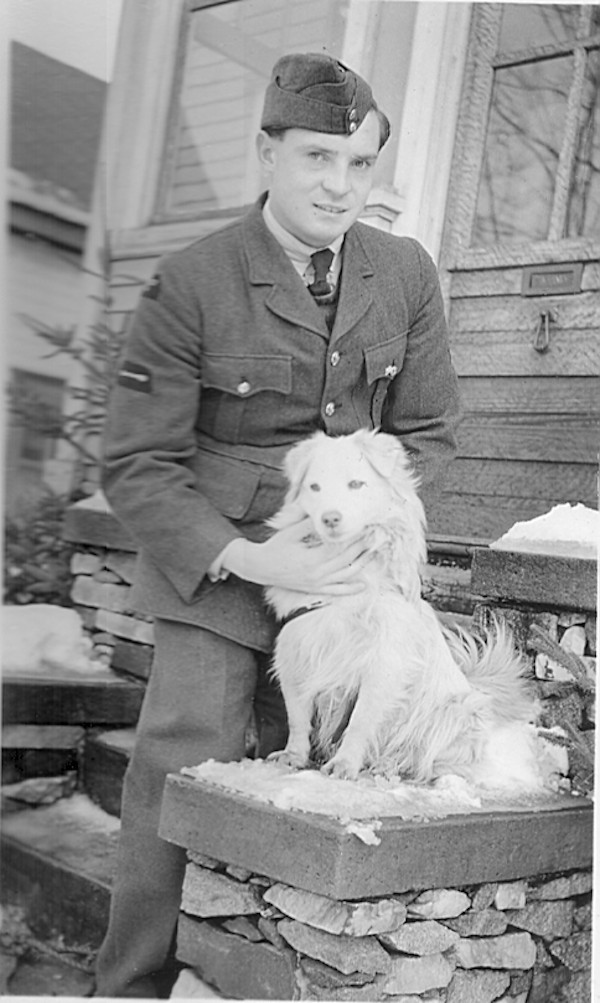 LAC James Shaw 1010811 and Teddy
LAC James Shaw 1010811 and Teddy
The local population could be supportive of these 'boys away from home' and the Sharp family
of New Glasgow offered their friendship. Mr Sharp was a monumental mason and lived across the road
from the Riverside cemetry. He owned an 'International' D2 pick-up truck, which must have been of
especial interest, given my father's earlier apprenticeship with an 'International' dealer in
Edinburgh. Mr and Mrs Sharp had three adult daughters, 'Ina', Daisy and Eleanor, the later two
living at home. They had a dog called Teddy.
parents. Daisy wrote many letters both to my father and his family back in Scotland. The Sharps also
sent some food parcels to Scotland too. (Mr and Mrs Sharp were both immigrants from Scotland).
Eleanor continued to live in the same house until 2015 so it is a pity that my father never found
his way back to Nova Scotia.
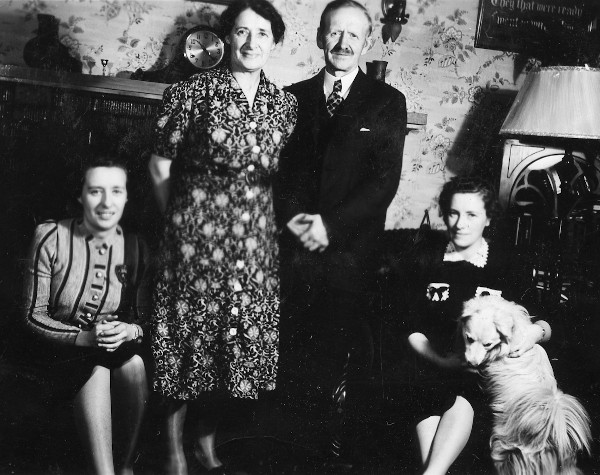 The Sharp Family
The Sharp Family
While at Debert my father was promoted first to Leading Aircraftman (LAC), in September 1941 and then
to Corporal in July 1942.
 1923-24 Model 'T' Ford, (Union Jack and 'Be The Ensign' in English & French between the
doors)
1923-24 Model 'T' Ford, (Union Jack and 'Be The Ensign' in English & French between the
doors)
He held a Novia Scotia driving licence and letters from Daisy Sharp mention the purchase of a car
and its expected 'three-point landing' in New Glasgow. It isn't known whether it was this Model 'T'
or whether it had just attracted his
interest. The various legends, 'No Overhead', 'White Rose', 'Pray As You Enter', 'This Is Like
Driving On A
Cloud', 'Be The Ensign', 'Why Walk' and the age of the car, (nearly twenty years old), suggest
youthful ownership.
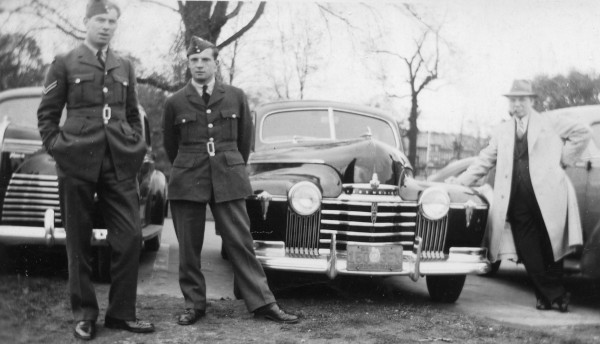 Chris Crossthwaite, Jim Shaw and Mr Hambleton (but probably not his car!)
Chris Crossthwaite, Jim Shaw and Mr Hambleton (but probably not his car!)
Friendships weren't limited to Nova Scotia. Perhaps as a result of being friends with RCAF personnel he
got to know the Hambleton family in Ottawa. They had a son, Doug, probably in his twenties, and
daughters, Isabel, Shirley and youngster, Margaret. In the winter of 1941-42 my father, Chris
Crossthwaite and the Hambletons visited the Canadian and American falls at Niagara.
During his stay in Canada my father had lost his fiancée back home but gained a pair of rubber
over-shoes, brown leather ice skates and the habit of eating with just a fork held in his dominant hand.
He appears to have left behind a small residue in a Post Office account and $25 with Daisy. She was
expecting to be acting as a third-party to receive the proceeds of selling the car but said that never
happened. Perhaps other arrangements were made or the buyer renaged on the deal? Once the war was over
and if nothing else had intervened it is quite likely he would have strongly
considered emmigrating to Canada.
In 1943 my father returned to the UK onboard RMS Queen Elizabeth. The ship was un-escorted
and relied
on her speed and 'zig-zagging' to avoid attack by U-boats. Safely home he attended a two-month
Air-Sea rescue course at RAF Hawkinge, near Folkstone, working on Spifires, Walruss and Lysander
aircraft for 277 Squadron RAF.
This was followed by a two-month instructor's course at RAF Cosford. He then served as an instructor
at RAF Innsworth for six months.
D-Day
On 7 April 1944 he joined 140 Squadron at RAF Hartford Bridge, (now Blackbushe airport, Hampshire),
shortly moving to RAF Northolt, outside London.
140 Squadron had been tasked with carrying out photo-reconnaissance to support the planning of the
D-Day landings. Originally employing Spitfires, by the time of the invasion they were only flying
the Mosquito. The squadron formed part of 34 Wing, along with 16 Squadron, which took over all the
Spitfire flying and 69 Squadron that used the Wellington.
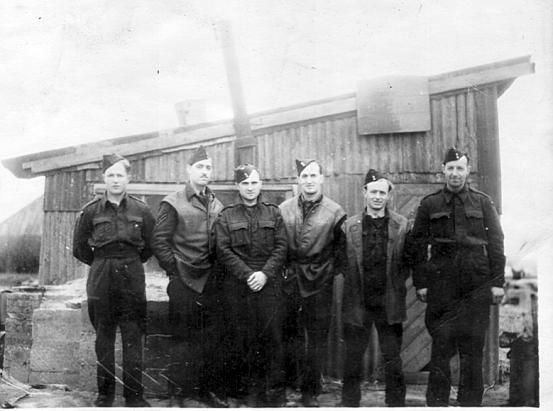 John Seward, [Instrument Cpl.], Frank Hodge, Bill Tawse, John Batchelor and Sgt. Morris
at dispersal, Melsbroek
John Seward, [Instrument Cpl.], Frank Hodge, Bill Tawse, John Batchelor and Sgt. Morris
at dispersal, Melsbroek
Following D-Day, in September 1944 the squadron moved to Balleroy and
then Amiens-Glisy in France. At the end of that month they moved to Melsbroek, Belgium
for five months.
Belgium - Melsbroek, Brussels
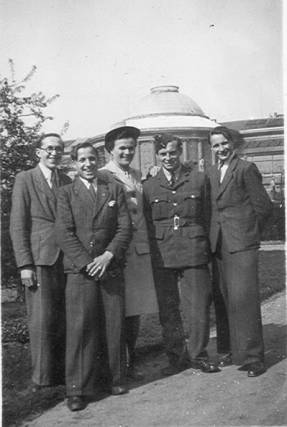 Edouard Strybos-Walgraef, Cyrille, Germaine, Jim Shaw and Henri at Brussels Botanical
Gardens
Edouard Strybos-Walgraef, Cyrille, Germaine, Jim Shaw and Henri at Brussels Botanical
Gardens
During that period my father made friends with the
Strybos-Walgraef family, Edouard, Germaine, Henri and Cyrille, who lived adjacent to the airfield in
Steenokkerzeel. They would do his washing in exchange for soap and cigarettes and from time-to-time
provide a proper bath! There was an exchange of
letters after the war up until at least 1948. In typical fashion my father visited them, out of the
blue, many
years later while testing cars in Europe.
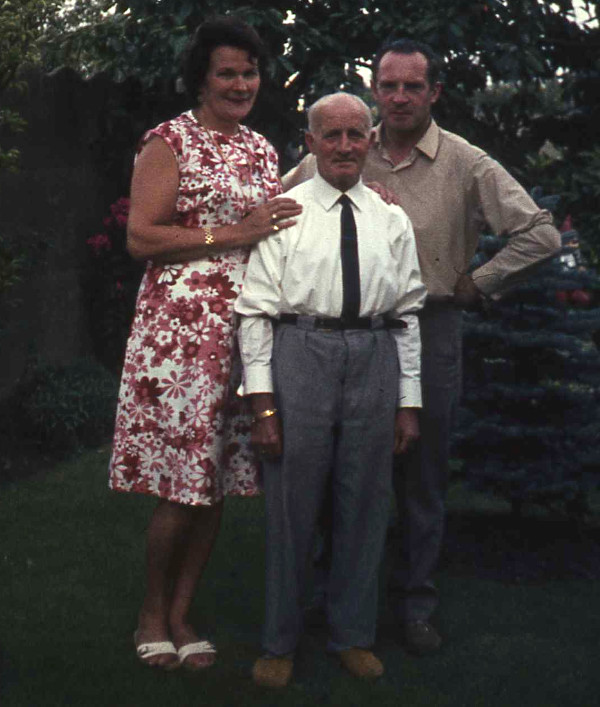 The Strybos-Walgraefs with Jim Shaw (about 1970)
The Strybos-Walgraefs with Jim Shaw (about 1970)
Another remembered interaction with 'the locals' was buying bunches of grapes, traded through the
perimeter fence.
'Operation Bodenplatte'
Melsbroek, along with seventeen other forward Allied airfields came under attack in the early hours
of 1 January 1945. Among the squadrons of 34 Wing based there 69 Squadron suffered the loss of five
ground crew, with twenty-five being injured. 16 and 140 Squadrons fortunately lost no personnel in
the attack. One Mosquito crew might have been a casualty but the for the navigator forgetting his
pipe and returning to the aircrew accomodation to fetch it. My father was doubly lucky, a few days
before one of 140 Squadron aircraft had suffered engine problems and had landed at Amiens. My
father had been despatched there to make repairs and flew back the day after the attack in the nose
of the repaired Mosquito.
From February 1945 until August 1945 the squadron was based at Eindhoven in Holland. Two daylight
sorties were carried out over the Skagerak in search of enemy shipping on 7 May 1945 and were
claimed to be the last operational sorties carried out by 2nd Tactical Air Force in Europe.
After the cease-fire ground crew were offered flights 'over the more devasted parts of Germany',
although my father didn't recall having done so.
Dispersal - Acklington and Colerne
On the 12 July 1945 the ground crew were flow to RAF Acklington, Northumberland to be re-mustered.
140 Squadron was formally disbanded at Fersfield, Suffolk on 10 November 1945 but by that time my
father had been posted to 39 Maintenance Unit at RAF Colerne, tasked with mothballing Lancaster
aircraft . It was during that period at Colerne that my father first met my mother who was working
as a nurse, 35 miles (56 km) to the west at Clevdon. Finally in April 1946 he was demobbed and he
returned to live in Edinburgh.
For his service he was awarded the 1939-1945 Star, the France and Germany Star, the Defence Medal and
the War Medal 1939-1945.
Some of the casualties of war that invoked strong memories from my father were the loss of popular
Squadron Leader Longley, (assumed to be from 'friendly fire' while piloting a Mosquito), and five
friends from school or church: Flt. Sgt. John Selby Ross, a Beaufighter pilot; Alec Carr, Medical
Corps; John A Watt and Ian
Allan, RAF Air Gunners; and Robert Fordie, soldier.
- John Archibald Watt, d. 30 August 1940, aged 20
- Robert Jameson Fordie, d. 5 November 1940, aged 20
- Ian Allan, d. 27 December 1941, aged 21
- John Selby Ross, d. 7 February 1942
- Alex Sydney Carr, d. 11 November 1943, aged 23
- Charles Douglas Nye Longley, d. 2 October 1944, aged 24
“They shall grow not old, as we that are left grow old:
Age shall not weary them, nor the years condemn.
At the going down of the sun and in the morning
We will remember them.”